Claude Werner brings a lifetime of experience behind the gun to every course he teaches. A retired U.S. Army officer, he served in Airborne, Ranger, Special Forces, and Mechanized Infantry units and commanded a Special Forces A-Team and Bradley Infantry Company.
He was the Chief Instructor at the elite Rogers Shooting School for five years and is currently an NRA Certified Instructor in several disciplines. A seasoned competitor, Werner is a Four Gun Master in the International Defensive Pistol Association and has won numerous sanctioned IDPA championships in the revolver division using snub-nose revolvers.
His training company is Georgia-based Firearms Safety Training LLC. He states that the company’s focus is on “concealed carry with smaller pocket size pistols, home defense training with pistols and shotguns, and enjoyment of the shooting sports, both formal and informal.”
The accompanying photos were taken during Claude’s Pocket Pistol bloc of instruction at last year’s Mid-Atlantic Tactical Conference.
PDN put its Top Ten questions to Claude, and this is what he had to say:
Why did you decide to become a trainer?
I’ve been doing it for 40 years; since I was in high school. It’s just a habit.
I decided to teach in my current genre of pocket pistols, scenarios, and performance improvement because I perceived a hole in the training industry. Very few trainers have the background as white collar business professionals to effectively train everyday people how to carry and use weapons on a 16/7 basis. Similarly, few trainers have been willing to demonstrate their skills in a measured arena, so their ability to teach long-term performance improvement is limited.
Lots of people teach shooting — in what ways do you teach it differently?
I believe in demonstrating and I do it to a very high performance standard. Adults tend to learn better from seeing what is expected rather than being told what is expected. Tell Them, Show Them, Make Them.
My students are aware of and accountable for every single round they fire, just as in the “real world.” Our targets are pasted after every single drill so the students know the exact result of every trigger press. Measuring results and having performance metrics are the only ways to achieve long-term improvement.
I prefer to conduct training in smaller and more frequent blocs. Even a weekend with me would consist of two entirely different programs of one day each. I am also doing one evening classes and like the results.
How do you motivate students to learn while in a class? What type of person should your students expect to deal with when they train with you?
Demonstrating what is possible and expected is highly motivational to the students. Being Chief Instructor at the Rogers Shooting School showed me how effective this is. The drills at Rogers are so difficult that students simply would not believe they are possible unless there was a demonstration. Once they see it done, they know it is possible. When I demonstrate that a snub-nose revolver is NOT just an “arm’s length gun,” I watch the lights go on for students as they realize that they can do it, too.
Training is leadership. I don’t supervise my students through the drills, I lead them through.
My students should know that I only expect from them what I expect from myself. However, my personal performance standards are high.
Who are your inspirations?
General of the Armies John J. Pershing, Thomas Edison, Director of Central Intelligence William Colby, President Thomas Jefferson, John Travolta, President Theodore Roosevelt, et al.
And who do you think are some of the best instructors teaching in your field today?
Bill Rogers, John Farnam, Ken Hackathorn, Tom Givens, SouthNarc.
What can students expect to take away from your courses?
They can perform to a higher standard than they ever thought possible. The only way to get to that standard is to work at it. Don’t be afraid to fail, especially in front of others; ego is the worst enemy of personal improvement and accomplishment.
Do you have a “typical” student? What is s/he like?
My students tend to be people who aren’t just looking for answers; they’re also looking for questions. No one in the training community has all the answers to a particular student’s situation. But by giving them questions to ask of themselves, the students may find a very good solution on their own. Sometimes, the questions are subtle and implied, but they are there nonetheless.
What’s your training philosophy?
- The first rule of tactics is “Do the best you can,” which I learned from John Farnam.
- Doing anything, even the wrong thing, is better than doing nothing. I learned that from being a Ranger.
- Having a gun, any gun, is better than having to resort to hand-to-gland combat in a deadly force situation. I learned that from my own experiences.
- Don’t shake your head at yourself. Accept what happened and shoot better the next time.
Looking ahead, what do you see in the future for yourself as a trainer? How about for your particular training industry?
The firearms training industry is going to have to adapt to a resource-constrained environment. Most people who have guns have limited resources to train and practice. Those resources, for the most part, consist of one lane on an indoor range, one box of ammunition a month, and a couple of hours or a few minutes here and there. We need to be cognizant that those are limitations most people have and help them make the most of what they have.
I haven’t completely broken the code on how to do that, but I am working hard on it.
What is something that you’ve changed your mind about and why? Something that you used to teach but now realize isn’t the best thing to teach your students or possibly a technique that you have replaced with something better?
I used to work on reloading a lot. One day I realized that the number one cause of reloading was missing the intended target. As a result, I now focus much more on shot-to-shot accountability and improvement. The ammo in your gun is much more important than the spare ammo on your belt.
We appreciate Claude taking the time to discuss his training methodology and the reasons behind it.






Claude, Nick Stanislo here. Hope this finds you well. Miss seeing you out at the Cherokee IDPA matches. I know you used to teach classes for small revolvers such as the S&W J frames and I believe some of those classes were specifically geared towards lady students. My wife has finally decided she wants to take responsibility for herself and has begun carring a S&W 642. There is only so much I can do for instruction and it always seems better when a person hears something from someone other than their spouse. Are you still giving classes that focus on small revolvers? If so, do you have a class planned for this year or next? If you're not planning any multi-student classes would you be open to a one on one day or two class with my wife? Thanks in Advance, Vr, Nick
Hi Claude. Will you be presenting at the Tactical Conference in LR next March? Respectfully, Bill Hayes